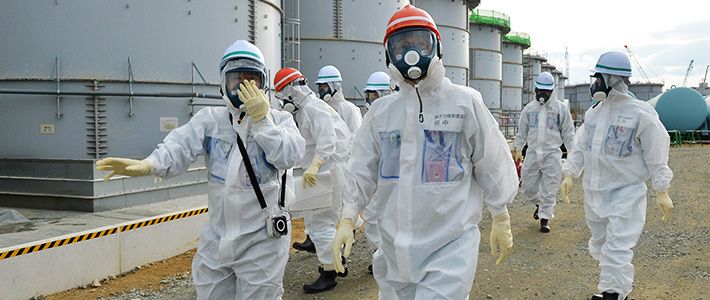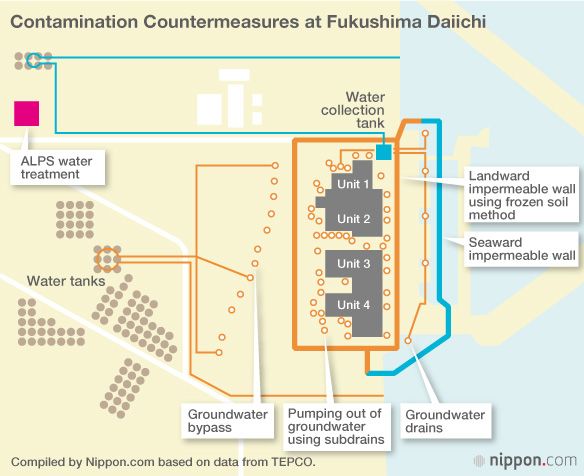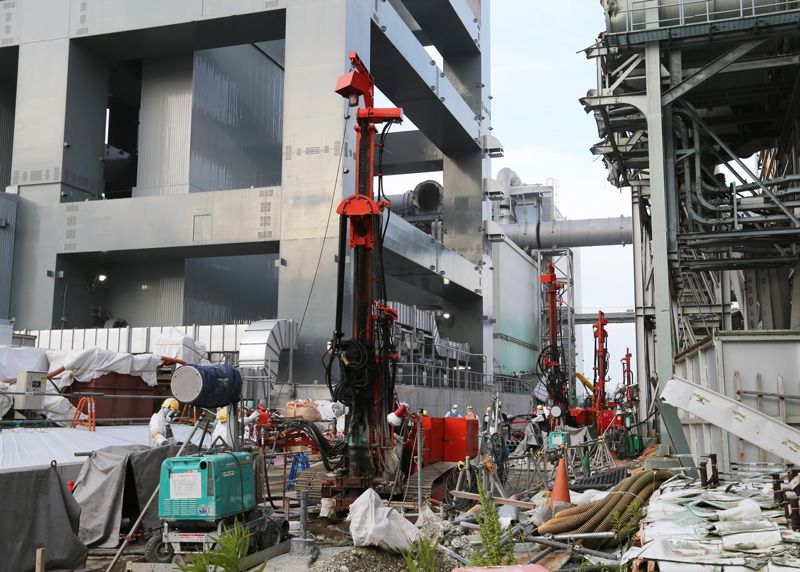
Contaminated Water Prevents Decommissioning: No Fundamental Solution in Sight
Science Technology Society- English
- 日本語
- 简体字
- 繁體字
- Français
- Español
- العربية
- Русский
Irradiated Water Still Being Produced Daily
The nuclear fuel that melted in the March 11, 2011, accident at Fukushima Daiichi Nuclear Power Station (Ōkuma, Fukushima Prefecture) has mixed with the water that was injected to cool the fuel rods and with the groundwater infiltrating the turbine housings, and it continues to produce some 300 tons of irradiated water per day. Moreover, massive amounts of seawater that flowed into the buildings in the tsunami remain pooled at the bottom of the buildings, also contaminated with radioactive materials.
Tokyo Electric Power Company, the plant’s operator, was tardy and on the defensive in its initial response to the disaster, and problems occurred in rapid succession, such as irradiated water flowing into the sea and leakages of contaminated water from storage tanks above ground. It was not until two and a half years after the accident that the government finally took over the reins and embarked on full-scale efforts to resolve the crisis. In September 2013 the government set down three principles for contamination countermeasures, and since then TEPCO has undertaken emergency steps and has also drawn up medium- to long-term measures in line with these principles. Government funding for the effort is expected to total about ¥47 billion.
Three Principles for Contamination Countermeasures
Remove the sources of contamination
- Clean up contaminated water using multi-nuclide removal equipment (ALPS)
- Remove highly contaminated water from seaward trenches
Isolate groundwater from the contamination sources
- Pump out groundwater using groundwater bypass
- Pump out groundwater using wells (subdrains) near buildings
- Install landward impermeable wall using frozen soil method
- Pave ground surface to prevent infiltration of rainwater
Prevent leakages of contaminated water
- Firm up ground with liquid glass
- Install seaward impermeable wall
- Install additional tanks (replace with welded-type tanks)
Recent Major Contamination Countermeasures by the Government
| 2013 | |
|---|---|
| March 30 | ALPS A begins trial operations (treatment capacity 250 tons/day; operations suspended in June). |
| June 13 | ALPS B begins trial operations (250 tons/day; operations suspended in August). |
| September 7 | Prime Minister Abe Shinzō declares to International Olympic Committee general meeting that the situation at Fukushima is “under control.” |
| September 11 | TEPCO pledges to complete treatment of highly contaminated water in storage tanks by end of fiscal 2014. |
| September 27 | ALPS C begins trial operations (250 tons/day). |
| November 21 | ALPS B resumes trial operations; two of the three existing systems are back in trial operation (total 750 tons/day). |
| 2014 | |
| February 20 | Approx. 100 tons of highly contaminated water is found to have leaked from aboveground storage tanks. |
| April 14 | Drawing of groundwater begins by activating pumps in groundwater bypass wells. |
| April 28 | Work commences to freeze approx. 10,000 tons of contaminated water accumulated in joints between Unit 2’s trench and turbine housing into “ice wall” and then drain contaminated water from trench. |
| May 21 | Release of groundwater from temporary storage tanks into sea begins. |
| June 2 | Work commences to install landward impermeable wall using frozen soil method; freezing scheduled to begin in March 2015. |
| July 21 | TEPCO announces plans to increase capacity of storage tanks for contaminated water by some 100,000 tons for a total of 900,000 tons by end of March 2015. |
| September 17 | Improved ALPS A begins trial operations (250 tons/day). |
| September 27 | Improved ALPS B begins trial operations (250 tons/day). |
| October 9 | Improved ALPS C begins trial operations (250 tons/day). |
| October 18 | High-performance ALPS begins trial operations (500 tons/day). |
| November 21 | TEPCO abandons attempt to plug seaward trenches with “ice wall” and switches to cement. |
| December 18 | Out of 11,700 tons of highly contaminated water accumulated in seaward trenches, removal of 2,510 tons completed. |
| 2015 | |
| January 19 | A worker falls to death while inspecting a rainwater tank. |
| January 23 | TEPCO announces it will not be able to meet its target of completing cleanup of highly contaminated water in storage tanks by end of March 2015. |
Half of Tainted Water in Tanks Still Untreated
To “remove the sources of contamination,” the government’s first principle, TEPCO has been working to clean up the radioactive water stored in tanks on the Fukushima plant’s premises. The accident released 31 kinds of radioactive substances, including cesium and strontium, and TEPCO aims to remove enough of these radionuclides from the contaminated water to bring the radioactive contents to safe levels. To that end, it has introduced seven multi-nuclide removal equipment (ALPS) systems capable of filtering out 62 kinds of radioactive substances, as well as two cesium adsorption apparatuses and two strontium removal units.
Trial operations of three ALPS units began sequentially from March 2013, and September 2014 saw the addition of three improved ALPS units capable of more efficiently decontaminating water. In October, ¥15.1 billion in state funding was provided to install a high-performance ALPS unit that uses a filter instead of chemical agents to pretreat the water. Of the roughly 560,000 tons of radioactive water stored in tanks, about half has been processed. As of January 2015, around 260,000 tons still awaited treatment.
The ALPS systems do not, however, remove all radioactive materials. Tritium, which emits beta radiation, takes the form of tritiated water and cannot be filtered out. Although tritium is considered to be low in toxicity and may be discharged into the environment within given limits, the final disposal of the water remains undetermined.
Another 11,700 tons of highly irradiated water occupies the seawater piping trenches (tunnels for housing pipes and electric cables) extending seaward from the Unit 2 and Unit 3 buildings, some of which is seeping down and tainting the groundwater below. In April 2014 TEPCO embarked on an unprecedented plan to first halt the influx of contaminated water from the buildings by freezing the irradiated water, thereby stopping the gaps, and then drain the trenches. But the water was flowing too fast to be frozen, and in November TEPCO abandoned this plan.

Influx of Groundwater Poses Biggest Challenge
TEPCO is also having difficulty with the second principle of “isolating groundwater from the contamination sources.” The area on the landward side of the Fukushima Daiichi power station is 30–40 meters above sea level, and groundwater from there flows directly underneath the reactors toward the ocean. Groundwater descending from the hills penetrates the plant’s facilities and comes in contact with the water that was injected into the reactors to cool the melted fuel. According to estimates made at the end of 2014, as much as 300 tons of water is being newly contaminated every day.
In an effort to stop the inflow of groundwater, TEPCO launched a groundwater bypass plan in May 2014. This involves pumping out groundwater on the landward side, temporarily storing it in tanks, and releasing it to the sea after testing the water quality. The aim is to reduce the volume of groundwater that seeps in by drawing up the water before it enters the buildings, thereby changing its flow and lowering underground water levels. TEPCO claims that as of September 2014 the operation had cut down the roughly 400-ton daily influx of groundwater by about 100 tons.
TEPCO is also considering the use of the subdrains, a system of wells encircling the plant buildings, to pump out the groundwater before releasing it to the sea. But the operator has not gone forward with the idea, which has yet to gain the acceptance of people in the fisheries industry worried about marine pollution.
In June 2014 TEPCO began construction of a landward impermeable wall using a frozen soil method. The plan is to install vertical pipes in the ground at regular intervals around the Unit 1 to Unit 4 buildings and freeze the surrounding soil by running a liquid coolant, chilled to minus 30 degrees Celsius, through the pipes. The resulting 1,500-meter ice wall is intended to shut out the massive flow of groundwater. This method has been successfully used in the construction of subway lines and undersea tunnels. But an earlier attempt to seal off the seaward trenches with ice walls failed, and the project to build a landward wall has not been going smoothly.
 Work on a frozen-soil impermeable wall on the south side of the Unit 4 reactor building at Fukushima Daiichi, released to the media on July 8, 2014. © Jiji.
Work on a frozen-soil impermeable wall on the south side of the Unit 4 reactor building at Fukushima Daiichi, released to the media on July 8, 2014. © Jiji.
Welded Tanks Added to Prevent Leaks
The centerpiece of efforts to “prevent leakages of contaminated water,” the government’s third principle, is a 780-meter-long seaward impermeable wall. A steel wall is being driven deep into the seabed adjacent to the embankment east of Units 1 to 4 to keep radioactive runoff that has seeped into the ground from flowing into the ocean. Construction began in October 2011, and the wall had reached a length of roughly 770 meters as of January 2015. Work is now underway to fill the space between the wall and the existing embankment.
TEPCO has also been replacing and adding storage tanks for contaminated water. In August 2013 some 300 tons of highly irradiated water leaked from a bolted flange tank, the highest amount to date. Japan’s Nuclear Regulation Authority rated it a level 3, or a “serious incident,” on a 0–8 international scale of nuclear events, the lowest level being 0. Flange tanks are crude containers consisting of steel plates bolted together and lined with rubber packing at the joints, and the government is speeding up the process of replacing them with welded tanks.
A single tank holds 1,000 tons. With 300 tons of water being contaminated daily, a new tank needs to be built every third day. That used to be every other day when the amount of newly contaminated water was 400 tons per day, and the work had to be done in protective gear. In July 2014, given the severity of the situation, TEPCO decided to add 100,000 tons to its target for additional aboveground tanks, bringing the total capacity to 900,000 tons by the end of March 2015. Over 1,000 tanks now populate the grounds of the nuclear power station, an eerie sight.
Empty Promises Lead to Calls for Fundamental Change
On January 23, 2015, TEPCO President Hirose Naomi reported to the government that the company would not be able to finish decontaminating all of the water stored in its tanks by the end of March as planned, largely because the ALPS equipment has been operating at lower treatment capacities than expected. Hirose estimated that treatment would be completed in May at the current rate. But it has been pointed out that water processed only with the strontium removal units will need further treatment by ALPS, which would push the date further forward.
In the campaign to host the 2020 Olympic Games in Tokyo, Prime Minister Abe Shinzō stated that the situation regarding water decontamination was “under control” in the hopes of alleviating concerns about the effects of the nuclear accident. TEPCO promised the completion of water treatment by the end of March 2015 under pressure from the prime minister, and this had become something of an international pledge.
As for the installation of a frozen-soil wall—another project that is proving difficult—TEPCO announced at a February 9 NRA meeting that it intended to begin freezing just a 60-meter section, or 6%, of the 986-meter stretch of wall on the landward side. It had initially hoped to get the system fully running before the end of March 2015. The development and construction of the wall will cost a total of ¥31.9 billion and is being entirely funded by the government. The NRA must give its approval before TEPCO can begin the freezing process, but this has yet to happen.
The crucial task of dismantling the reactors at the crippled plant cannot be tackled until a solution is in sight to the problem of contaminated water. The entire decommissioning process is expected to take as long as 30–40 years. And Japan is still stuck at step zero of the process. Some are calling for a fundamental review of the plans, and as time passes the outlook only seems to grow in uncertainty.
(Originally written in Japanese by Nagasawa Takaaki of the Nippon.com editorial department and published on February 25, 2015. Banner photo: On December 12, 2014, Nuclear Regulation Authority Chairman Tanaka Shun’ichi, center, tours a part of the Fukushima Daiichi Nuclear Power Station lined with tanks for storage of contaminated water.© Jiji.)
Great East Japan Earthquake Fukushima Daiichi Nuclear Power Station TEPCO multi-nuclide removal equipment ALPS frozen-soil wall nuclear decommissioning